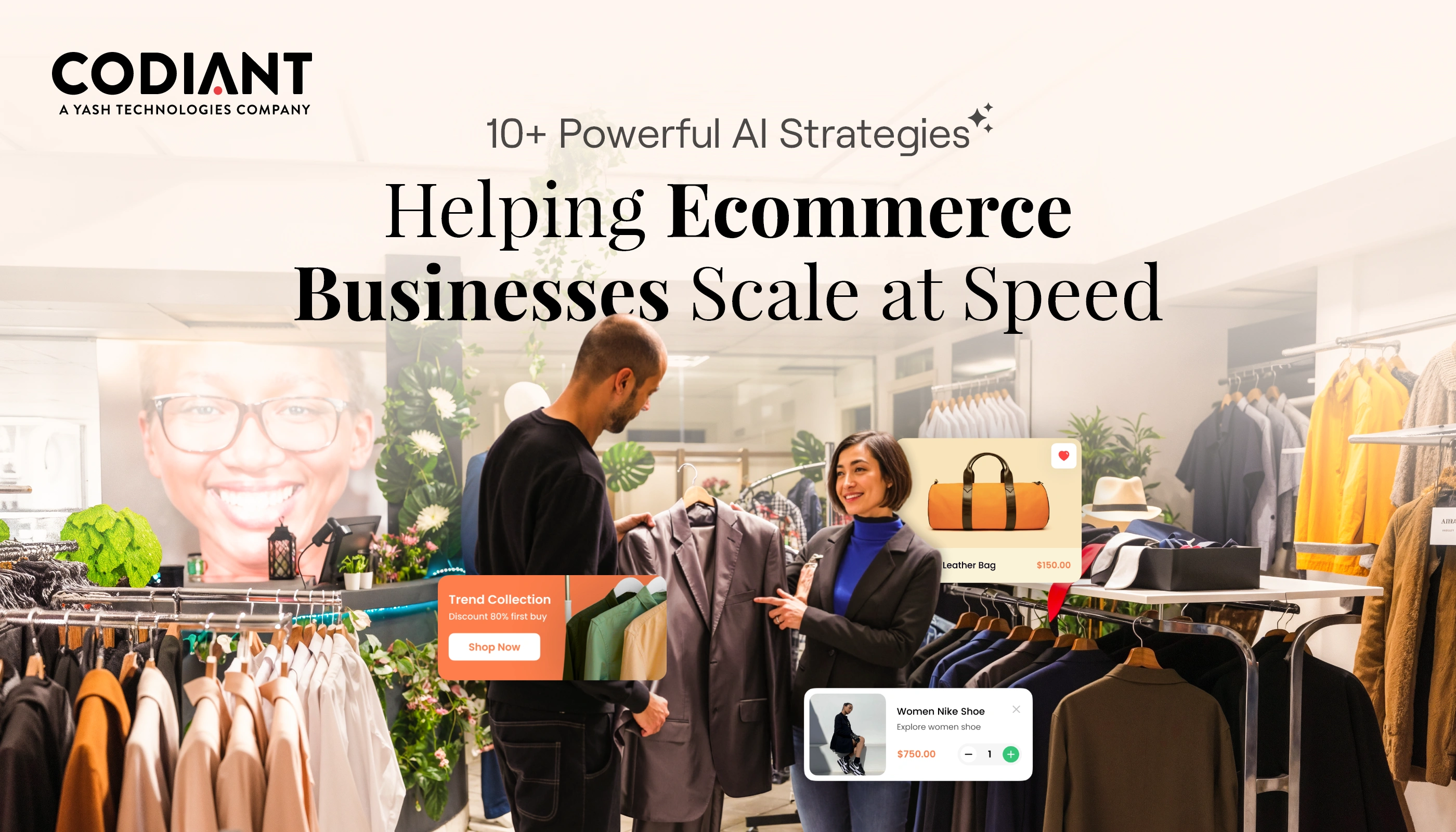Complete Guide On Brick And Mortar Stores Going Online
Table of Contents
Subscribe To Our Newsletter

In 2023, online shopping grew a lot—55% more than the year before. The significant rise after Covid-19 indicates that more people are using online shopping. This trend is getting bigger every day! It is estimated that 2.77 billion online shoppers are expected by 2025! And thus, the demand for brick-and-mortar stores going online is rising exponentially.
It’s such a huge number that overall accounts for 25% of the total world population. It’s high time to enhance your digital presence.
However, many retailers find it difficult to step into an online store. May be because of a lack of technology expertise or fear of not knowing the world of online marketing.
We as a leading E-Commerce Development Company, have helped 700+ startups to transition their businesses from offline to online. Here in this guide, we’ll lead you through easy steps with tips to expand an ecommerce business.
How to Create Your Brick and Mortar Store Online?

Follow these 10 simple steps to introduce your traditional retail store to the online world. Doing so will help you build a strong online presence for your customers.
1. Understand Your Audience
Know who your potential customers are and how they behave online. After that, you need to identify preferences, shopping habits, and competitors in the digital space.
2. Develop a Business Plan
Make a detailed business plan. The plan must outline the goals of your store, your target audience, effective marketing strategy, and other financial terms. Certainly, you can use this plan as a roadmap for a successful online transition.
3. Select an eCommerce Platform
Firstly, pick one of the eCommerce platforms among WooCommerce, Shopify, or Magento that align with your business needs. Secondly, consider factors like store features, scalability options, and user-friendliness. You can develop a fully functional e-commerce store, online marketplaces, or social commerce networks.
Fully functional e-commerce sites often use these ready-made solutions. These options are not only free and open-source but also allow unlimited customizations for your online business. Its crucial to choose the best eCommerce platform as per your requirement.
Join online marketplaces like eBay, Alibaba, or Amazon – they are hassle-free. You don’t need to buy a license, but you pay a commission and follow their rules.
Social commerce networks made selling on social media easy. Link your store for easy promotion. Also, you should know that limited customization options may require extra resources.
4. Design Responsive eCommerce Site
Good web design is crucial for a successful online business. Choose a template or design your own, but make sure it looks unique to represent your brand.
Create an easy-to-navigate website. Go for responsive design to help customers use it on their mobile devices.
A well-thought-out design with clear interactions, high-quality product presentation, and smooth payment methods.
Easy filtering option is the key to attracting more customers and differentiating your business from the rest in the market.
5. Create Appealing Product Pages
When folks check your online store, they decide whether to buy on the product page. It’s just one click away from a purchase. But, if your product pages aren’t awesome for sales, they won’t buy. So, it’s vital to make product pages that change visitors into customers on your online store.
Create high-quality product images. Showcase products from different angles for customers.
Product pages should resonate your brand with your customers.
Make short product descriptions and highlight key features to give enough information about the products and increase sales.
Add reviews and ratings options on product pages to build customer trust and increase conversion rates.
6. Integrate Secure Payment Gateway
When deciding on online payment methods, there are a few key things to think about and have a safe shopping experience.
Choose how customers pay, either with credit cards using Shopify Payments or a third party.
Explore options like PayPal, Amazon Pay, and Apple Pay for non-credit card payments.
Speed up checkouts for returning customers with features like Shop Pay, saving their info for a faster experience.
7. Implement Inventory Management
Efficiently manage inventory to avoid overselling with a robust system. Doing this makes your business run better, with fewer mistakes, and gives customers a great online shopping experience.
Make a digital list of your products with details and pictures. Keep it all organized in one place to know your stock easily.
Use a barcode or RFID for simple tracking and fewer mistakes. Get alerts when you’re low on products.
Connect this system to your online store for smooth orders and updates. In addition, check physical stock with digital records regularly.
8. Set Up Shipping and Delivery
Determine shipping options and costs, and communicate clearly to customers. Plus, you can provide various delivery methods, including expedited shipping.
Set up convenient shipping options for your online business to keep it resilient during economic uncertainty. This ensures smooth order fulfillment and a positive experience for customers.
Customize shipping rates based on destination, size, weight, and item quantity. Keep shipping notifications updated across channels for customer convenience, and provide a tracking system.
Use live shipping rates from third-party carriers (DPD, UPS, FedEx, DHL) for accurate calculations. Include surcharges to cover packaging and fulfillment costs while offering global and local delivery options for customer flexibility.
9. Add Return & Refund Policy
Having a clear return policy in writing helps set straightforward rules for customers seeking replacements or refunds. Handling returns case by case can be complex and costly. So, having set guidelines is more effective.
10. Provide Excellent Customer Support
Offer responsive support through live chat, email, and phone. And, address customer queries promptly to build trust.
Moreover, you must keep up with industry changes and update your website regularly. Adapt strategies to stay ahead of the dynamic digital competition.
Must Read: Top 7 Best Payment Gateways in the USA for the E-commerce Store
Best eCommerce Business Models

In the last 5-10 years, eCommerce has changed a lot, offering different business models to meet customer needs. If you want to start or grow your online business, it’s crucial to know about these changes in brick mortar web design. There are numerous eCommerce business models helping businesses to match consumer demands.
Below are the top eCommerce business models. Have a look-
1. Business to Consumer Model
B2C is the traditional e-commerce model that helps buy stuff online. This is useful when businesses sell things right to people. Like Amazon, Walmart, and Nike’s online store.
2. Business to Businesses Model
The B2B model is beneficial for businesses that deals with other businesses. It involves manufacturers, wholesalers, and distributors. For example, Alibaba and ThomasNet.
3. Consumer to Consumer Model
In C2C model, people are selling to people. It uses platforms where regular people sell stuff to each other. For example, eBay and Craigslist.
4. Consumer to Business Model
C2B model is useful when you are selling to companies. Likewise, when regular people sell things or offer services to businesses. Think of influencers or people creating content for companies.
5. Direct to Consumer Model
This is known as Peer-to-Peer model. It skips the work of middlemen in selling things. To clarify, it is considered by top brands that don’t go through stores. They sell right to you online. Like Warby Parker and Casper.
6. Subscription-Based eCommerce Model
It is like subscriptions for stuff. Using this model, you need to pay regularly for things you want. Netflix, Birchbox, and Adobe Creative Cloud are examples.
7. Dropshipping Model
In dropshipping model, there is no need of inventory to place the product. This means that it is a good choice for the stores that don’t keep stuff in stock. They work with others who send products straight to customers. Shopify stores often do this.
8. Crowdfunding eCommerce Model
This eCommerce model allows getting money for ideas. For example, use websites like Kickstarter to get a bunch of people to give money for a new product or idea.
The transition from traditional business to online makes sense. Each e-commerce model comes with its own set of advantages and challenges. So, careful consideration is essential to align with your business goals.
Benefits of Moving Brick n Mortar Store Online

1. Reaching Customers Worldwide
Expand your reach by selling to people worldwide through an online store. Attract online shoppers and tap into new markets. Stay connected with customers by providing discounts and freebies, making it convenient for them to shop from the comfort of their homes.
2. Personalized Experiences
Customers love a personalized shopping experience. So, personalized experiences satisfy customers. When they share information, use it to offer special deals and events, increasing satisfaction and loyalty. By tailoring your approach, you maximize the impact of your efforts and improve the return on investment (ROI).
3. Huge Cost Savings
Moving from physical stores to online platforms allows for more efficient warehousing. Instead of big retail spaces, consider mini-warehouses or self-storage solutions, saving costs and speeding up order fulfillment. This not only reduces storage expenses but also enhances customer service.
4. Enhanced Decision-Making
Customers provide valuable data when shopping online. Analyze this information to gain data-driven insights into their preferences and behaviors. Use these insights to target customers more effectively and provide personalized experiences. This data-driven approach can significantly boost sales and fuel your e-commerce business.
5. 24/7 Accessibility
Running a business online 24/7 builds customer relationships. Whether customers want to know some product details, leave a review, or give ratings, being available all the time is crucial. This constant accessibility not only keeps customers happy but also helps build and maintain valuable relationships.
These steps can make it easy for you to get started in online retailing. Operating your store online without much technology knowledge is nothing to hesitate of. Once you get started by selecting the right technology partner and stakeholders, everything starts to become a breeze.
Frequently Asked Questions
Moving your Brick n Mortar store online help you increase your customer reach, provide more flexibility, keep up with the latest shopping trends. And, this leads to overall better sales.
The most important steps include selection of an e-commerce platform, responsive web design, and secure payment gateway. All these steps help build a strong online presence.
Start with popular or unique items that have high demand. As you progress, expand your online inventory based on customer preferences and market trends.
For better online shopping experience for customers, make website easy-to-navigate, give detailed product description, and provide customer support.
Use social media, run email marketing campaigns, and offer online promotions to drive traffic to your virtual store. Collaborate with influencers and use SEO techniques to improve visibility and boost your online presence.
A click-and-mortar business combines online and physical stores smoothly. Customers can shop both online and in real stores, making it flexible for them. This type of business uses the benefits of online shopping, like reaching more people and being open all the time. But it also gives customers the hands-on experience of traditional stores. This mix keeps customers happy and coming back, boosting sales.
Featured Blogs
Read our thoughts and insights on the latest tech and business trends
How AI Helps eCommerce Businesses Scale Faster: 10+ Proven Strategies
- December 4, 2025
- Artificial Intelligence E-commerce
Running an eCommerce business today means managing more products, more customers, and more data than most teams can handle manually. As order volumes rise, tasks like customer support, inventory planning, product discovery, and marketing start... Read more
How to Choose the Right AI Solutions for Your Existing App
- December 1, 2025
- Artificial Intelligence
Businesses today are under pressure to move faster, deliver personalized experiences, and operate with greater accuracy. This is why many enterprises and startups are now looking for ways to add AI features to their mobile... Read more
How to Enable AI for Smart Diet Planning and Client Progress Tracking
- November 26, 2025
- Artificial Intelligence
Smart diet planning and consistent progress tracking have become essential in a world where people want faster, more accurate ways to manage their health. Traditional methods like manual calorie counting or generic meal charts often... Read more




